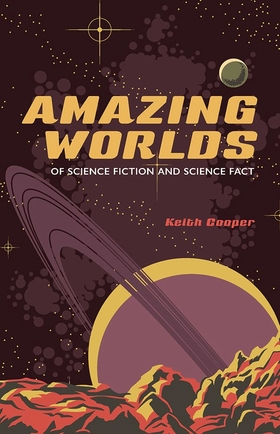Centauri Dreams
Imagining and Planning Interstellar Exploration
Interstellar Expansion: Colonizing Ice Dwarfs
Are habitable planets the best places to look for life? The question seems odd, because we’re assuming life has to have clement conditions to emerge and survive. But step beyond the question of life’s formation and the issue can be framed differently. Where beyond its birthplace might life migrate? In SETI terms, where might we look for the signature of a civilization advanced enough to move beyond its home world and expand between the stars?
A lot of ideas seem to be converging here. In Huntsville, Ken Roy (whose description at the recent interstellar conference was ‘an engineer living and working amidst the relics of the Manhattan Project in Oak Ridge, Tennessee’) described potential habitats stretching far out into the Solar System and beyond. Roy has been working for some time with Robert Kennedy and David Fields on colonization scenarios.
My own talk covered the kind of places where we might extract resources, ranging from icy dwarfs like Pluto to cometary objects and ‘rogue’ planets without any star. And science fiction author Karl Schroeder, in a recent blog post called A Tale of Two Worlds, also brought the topic up. Let me quote Schroeder, because I want to return to his post in a day or so:
…it’s important to bear in mind that habitability and colonizability are not the same thing. Nobody seems to be doing this; I can’t find any term but habitability used to describe the exoplanets we’re finding. Whether a planet is habitable according to the current definition of the term has nothing to do with whether humans could settle there. So, the term applies to places that are vitally important for study; but it doesn’t necessarily apply to places we might want to go.
Both Schroeder and Roy are assuming not near-term projects but the kind of settlement and terraforming that draw on huge resources of energy. The premise, in other words, is that we’re talking about a culture that ranges freely through its own system, having mastered fusion or other technologies and being capable of large-scale building projects in space and on planetary or other surfaces. Grant that premise and then think about what kind of structures it might make sense to build when exploiting local resources and looking out toward the stars.
Pluto and the Ice Dwarfs
Pluto is a case in point. Here we have a surface that appears to be a shell of nitrogen ice covering water ice. When New Horizons gets to the Pluto/Charon binary in 2015, one thing to look for is an equatorial bulge that could have been left over from the early days of Pluto’s formation. No bulge makes the case for stretching of the ice shell over Pluto’s lifetime, strengthening the possibility some are noting that the ice dwarf could contain an ocean beneath about 165 kilometers of crust, an ocean that may be just as deep as the crust is thick (see The Case for Pluto’s Ocean for more).
As Roy told the crowd in Huntsville, icy worlds like Pluto are rich in volatiles, and of the tens, if not hundreds of thousands of Kuiper Belt objects out there between 30 and 50 AU, several hundred may be Pluto-size. Such worlds are doubtless common not just here in our own system but as rogue planets in interstellar space and perhaps circling brown dwarfs, those dim objects that blur the distinction between gas giants like Jupiter and true stars like Proxima Centauri.
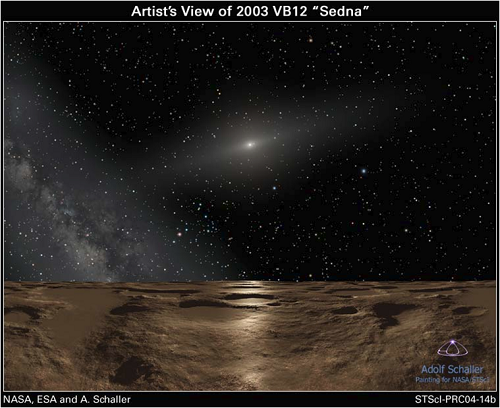
Image: This artist’s conception of the ‘scattered disk’ object Sedna reminds us that even beyond the Kuiper Belt and as we move into the Oort Cloud, vast numbers of icy objects are thought to exist. Can we exploit these as we move outward toward another star?
Build a settlement on an ice dwarf in the outer system and you are not only creating space for living and doing science, but also building the technologies that will one day be used in interstellar colonization missions. But Roy noted that the science fictional image of a domed city in a harsh landscape just won’t work here. Induce Earth-class atmospheric pressure inside such a dome and even a small one (1000 feet in radius) would require a four-inch thick layer of steel to keep the dome intact. Moreover, ice dwarfs have but feeble gravity, creating medical issues from muscle atrophy to bone problems, loss of body mass, sleep disturbance and more. A better choice, then, is to move inward, creating the colony deep within the ice dwarf itself.
At 160 meters, the ceiling of a colony hollowed out within Pluto would be fully supported by the air pressure inside. Artificial light would be essential, of course, and we still have a gravity problem, for Pluto’s gravity is only 6.7 percent that of the Earth — a 200 pound person on Earth weighs but 14 pounds on Pluto. Roy suggests a rotating torus in this setting could provide living and working spaces at 1 Earth gravity. At 1 revolution per minute, a 1790-meter torus supported by maglev rails could accommodate, by Roy’s estimation, 10,000 people living in conditions that would more or less resemble the worldships so often imagined by science fiction writers.
We’re assuming technologies that can create large rotating structures in low-gravity environments, with the ability to move spacecraft at velocities of 0.001 c to build and supply the colony. We’re also assuming proven fusion power plants and considerable expertise in mining and construction. We would put these tools to work to extract local silicates and metals from the surface and, perhaps, rock from buried impactors. We would be working in an environment rich in H2O, but also in methanol, hydrogen cyanide, formaldehyde, ethanol, ethane and long-chain hydrocarbons, all within a salty ice mantle.
Interstellar Migration
Here’s long-haul migration to the stars presented as a series of steps at 0.001 c. Moving roughly 400 AU at a time between various objects in the outer system and, eventually, interstellar space, we spend 50 years at each to establish a colony and then build and crew another ship. The 4.2 light years to Proxima Centauri in this scenario demands 664 such jumps and reaches the star in 38,000 years, leaving a chain of colony worlds behind that are self-sustaining.
The technologies needed for this kind of expansion are well beyond us, but it is not inconceivable that more advanced cultures as they move up the Kardashev scale may have accomplished such things. Places that are habitable, as Karl Schroeder says, are not the same thing as places that are colonizable, and it’s also true that we have to be wary of imputing human motivation to hypothetical extraterrestrial civilizations. Their detectable artifacts, in other words, might extend between the stars far into the interstellar deep and so, in some remote futurity, might ours.

Near-Misses and their Uses
We can hope that the celestial events of February 15, including the spectacular fireball over Chelyabinsk and the near-miss from asteroid 2012 DA14, have raised public consciousness about Earth’s neighbors in space. And indeed, this seems to be the case. Media outlets were flooded with articles, photos and video, and talk show hosts found themselves asking what could be done to prevent future impacts. Could all of this prompt a new surge of interest in space?
The scenario is exactly what Arthur C. Clarke wrote about in Rendezvous with Rama (1972), where what it takes for humanity to get serious about developing a protective system (and, by extension, about pushing its space program forward) is an impact. We can be grateful that the one we’ve just seen was far smaller than Clarke’s, as described in the first chapter of the novel:
At 0946 GMT on the morning of September 11 in the exceptionally beautiful summer of the year 2077, most of the inhabitants of Europe saw a dazzling fireball appear in the eastern sky. Within seconds it was brighter than the Sun, and as it moved across the heavens — at first in utter silence — it left behind it a churning column of dust and smoke.
Somewhere above Austria it began to disintegrate, producing a series of concussions so violent that more than a million people had their hearing permanently damaged. They were the lucky ones.
Clarke goes on to recount the impact in northern Italy, where Padua, Verona and Venice are destroyed by the combination of impact and tsunami. The deaths of 600,000 people and the great chunk torn out of human history create a resolution that this must not happen again, and out of this is born the system of radars that eventually finds the alien intruder dubbed Rama. Clarke’s book is about the encounter with this enigmatic vessel, but the asteroid-warning radars he imagines create the kind of warning grid we may eventually put in place.
The B612 Foundation has been making the case for asteroid detection and mitigation studies for some years now. Its Sentinel Space Telescope is scheduled for launch in 2018, with the aim of detecting over 90 percent of asteroids over 100 meters in diameter — these are the ones large enough to destroy an entire region of the planet if they were to hit us. Sentinel also aims to track more than 50 percent of near-Earth asteroids in the DA-14 category. With decades of warning, says CEO Ed Lu in this B612 news release, we can use existing technology to destroy or alter the trajectory of any such objects.
Chelyabinsk and 2012 DA14 also put the University of Hawaii at Manoa’s work on ATLAS into the news. The Asteroid Terrestrial-Impact Last Alert System — an ominous title, that — is to operate eight telescopes, each with a camera of up to 100 megapixels, on sites in the Hawaiian Islands. The goal here is to offer, according to this news release from the university’s Institute for Astronomy in Honolulu, a one-week warning for a 45-meter asteroid and a three-week warning for a 140-meter object. That’s enough time, according to astronomer John Tonry, “to evacuate the area of people, take measures to protect buildings and other infrastructure, and be alert to a tsunami danger generated by ocean impacts.”
But among the spate of asteroid warning news items that surged over the weekend, the project that caught my eye first was one called DE-STAR, the explanation of whose acronym is so tortuous that I will direct you to the University of California at Santa Barbara news release it appeared in. What UC-Santa Barbara researchers Philip Lubin and Gary Hughes are proposing is a system that could, over the course of a year, destroy asteroids ten times larger than 2012 DA14, using a massive phased array of lasers to break up or evaporate the object.
Says Hughes:
“This system is not some far-out idea from Star Trek. All the components of this system pretty much exist today. Maybe not quite at the scale that we’d need — scaling up would be the challenge — but the basic elements are all there and ready to go. We just need to put them into a larger system to be effective, and once the system is there, it can do so many things.”
DE-STAR is being described as a ‘directed energy orbital defense system,’ one that uses solar energy to feed its lasers. The researchers have calculated DE-STAR systems in various configurations, including a 100-meter DE-STAR 2 and a 10-kilometer DE-STAR 4, the latter capable of delivering the energy needed to obliterate a 500-meter asteroid in about a year.

Image: Concept drawing of the DE-STAR system engaging both an asteroid for evaporation or composition analysis, and simultaneously propelling an interplanetary spacecraft. Courtesy Philip M. Lubin.
And now we start getting into Bob Forward territory as Lubin and Hughes go on to describe a DE-STAR 6 that would function not only in asteroid defense but as the propulsion system of an interstellar spacecraft, beaming enough laser energy to the craft to get it up to a substantial percentage of the speed of light. An asteroid mitigation strategy that involved planetary safety, power generation and spacecraft propulsion is a tempting long-term goal, but a DE-STAR 2 about the size of the International Space Station could begin small-scale trajectory alterations on a variety of objects as we experiment with planet-defending techniques.
Meanwhile, many of us talked to Claudio Maccone at the Huntsville conference and learned of his plans to attend the IAA’s Planetary Defense Conference, coming up in Flagstaff on April 15-19. Claudio crosses the ocean all the time, as inveterate a conference-goer as I’ve ever seen, but who would have thought this year’s Planetary Defense meeting would become so highly visible? You can bet media coverage at Flagstaff will be considerably higher than in years past thanks to Chelyabinsk and 2012 DA14, making them unusually effective wake-up calls for our species.

Alpha Centauri Sunrise
If the title of this piece conjures up exotic images, that’s all to the good. In fact, I’m surprised that “Alpha Centauri Sunrise” hasn’t been the title of a science fiction story somewhere along the line, but a quick check shows no such reference. Thus when Robert Kennedy (The Ultimax Group) created a drink called the Alpha Centauri Sunrise at our recent conclave in Huntsville, he was breaking new ground. And maybe images of a double sunrise also came to mind, the view from an as yet undiscovered world where Centauri A is a bright flare in the morning sky while a still closer Centauri B begins to nudge up over the hills, flooding the scene with orange light.
And what happened to Proxima Centauri? It would not be a factor in a scene like that, its light so dim that it would not stand out from other stars in a completely dark sky. Only its proper motion would alert local astronomers to how close it was (roughly 15000 AU). But let’s drink to Proxima anyway. I promised the recipe for the Alpha Centauri Sunrise two weeks ago and it’s time to deliver, as a number of readers have reminded me. Here we have it, from the pen (or keyboard) of Robert Kennedy himself:
The Alpha Centauri Sunrise
Best served in a martini glass or a champagne flute to accentuate the color gradient.
Ingredients:
1 jigger Tennessee moonshine;
2 jiggers Red Bull (different cognate but Centauri sorta suggests a bull, plus one of the stars is reddish);
4-6 oz. orange juice;
½ tsp. grenadine (to make the red-to-yellow color gradient);
three little red berries (to represent the three suns of the triple star system: α Centauri A, α Centauri B, and Proxima Centauri.
If, after all these puns, your customer still doesn’t crack a smile, then instead of three little red berries, give him a big raspberry (literally or figuratively).
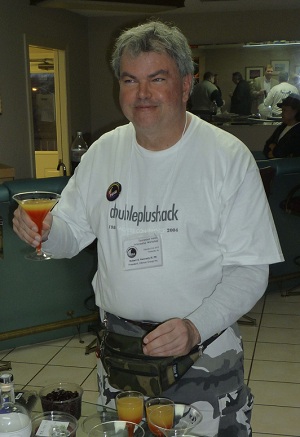
With an Alpha Centauri Sunrise in hand, you might want to recall some of the great science fiction venues where drinks like this might be served. Callahan’s Place is the creation of Spider Robinson (it’s immortalized in Callahan’s Crosstime Saloon), a place where time travelers make the occasional appearance and aliens from a variety of worlds might wander in at any time. Robinson devotees will recognize ‘Callahan’s Law’: “Shared pain is lessened, shared joy, increased – thus do we refute entropy.” And I would say that refuting entropy is a task worth accomplishing.
Callahan’s, of course, had forerunners, among them Gavagan’s Bar, which was the work of Fletcher Pratt and L. Sprague de Camp, depicted in a series of tall tales (most of them, I believe, written for John Campbell’s Unknown) and collected into a 1953 book. The one that comes most readily to my mind, though, is Arthur C. Clarke’s Tales from the White Hart, a 1957 collection that brought science fiction and pub culture to a triumphant peak. These stories are still lively today, and recall a time when the members of the British Interplanetary Society and science fiction fans met regularly at such venues.
Image: Alpha Centauri Sunrise creator Robert Kennedy with the finished product.
Of course there are wonderful movie and TV bars in science fiction, from the Mos Eisley Cantina on Tatooine (Star Wars) to Star Trek‘s Ten Forward, which is where I would have spent my time on the Enterprise whenever possible. But Britain’s pub culture gave birth not only to Clarke’s Harry Purvis, the raconteur who spun his tales, but also to the British Interplanetary Society’s later work on Project Daedalus, the fusion starship design. Much of their work took place in a pub called the Mason’s Arms, where propulsion concepts and target stars offered just as magical a look at reality as anything in the White Hart. Thus it’s written SF and the White Hart I come back to when thinking of starships and bars.
Harry Purvis could hardly have had better companions than I had in Huntsville. Looking toward next week, I’ll be tapping the ideas of one of these, Ken Roy (The Ultimax Group), whose thoughts on colonizing outer system and deep space objects dovetail beautifully into my own thinking on gradual expansion into the Oort Cloud. Ken is a frequent contributor with colleagues Robert Kennedy and David Fields in venues like JBIS and Acta Astronautica. We’ll soon be looking at an unusual take on terraforming and how it might transform human expansion.
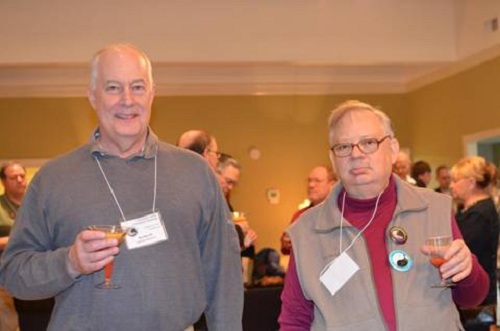
Image: Robert Kennedy’s co-author Ken Roy (left) and ‘neighbor/fellow habitué of the Friday Night Dinner Club’ John Preston, with Alpha Centauri Sunrises in hand.

The Draco Kill Shot
When I was in Huntsville for the recent interstellar conference, I noticed people walking around with black rubber wristbands that said ‘Build a Star Ship.’ Space educator Mike Mongo was handing these out to all concerned, and I soon picked one up to give my grandson. They’re an interesting form of marketing — leave these in the right places and kids pick them up. Maybe it becomes a fad to wear them. The point is, you never know whose mind you might reach. And maybe once or twice, you give a wristband to a kid who starts dreaming about the stars, and pretty soon that leads to a course of study and then one day a career.
The Roman historian Plutarch said it best: “The mind is not a vessel to be filled, but a fire to be ignited.” And when ignition occurs, it’s often a sudden, passionate event rather than a slow building of sequential ideas. It’s that fire that drives subsequent study and makes long hours amidst the databases and classrooms pay off in the form of eventual insights and discoveries. I’m thinking maybe I’ll get a few more of Mike’s wristbands so my grandson can hand them out at school.
I think about reaching broader audiences every time I attend a conference, and in fact we did have an excellent public session on the last night of the Tennessee Valley Interstellar Workshop. It was held at Calhoun Community College, where Icarus Interstellar’s Bill Cress showed some of the video work he had done to promote the cause. I followed with my talk on gradual migration beyond the Solar System, tapping resources like the Oort cometary cloud and wandering ‘rogue’ planets without stars of their own. We capped the event with a panel discussion led by Les Johnson between Kelvin Long (Institute for Interstellar Studies), Richard Obousy (Icarus Interstellar), veteran space engineer Gordon Woodcock, Bill Kress and myself. The questions raised by the audience were excellent and we could have talked for hours if we had the time.

But beyond the public outreach in Huntsville there was a striking example of what I might call public ‘in-reach,’ in the form of William Lucas, a 15-year old high school student who, it is easy to predict, has a bright future ahead of him in whatever field he chooses. Les Johnson made an inspiring choice in scheduling William just after Jan Davis’ keynote address. What William seems to have done is to discover a gamma ray burst before anyone else, leading to a parade of complications with local authorities and even the US Air Force. His presentation was quiet, analytical and used slides and video to great effect. He totally won over his audience.
I’m thinking this is no mean feat. When I was 15 years old, I was reading science fiction magazines, getting crushes on various girls and writing bad poetry. And here was William Lucas, up in front of a room full of scientists and engineers many of whom were old enough to be his grandfather, making a world-class presentation as if this were the kind of thing he did every day. People were buzzing during the break about the skill with which he pulled this off.
Image: William Lucas, presenting his findings at the Tennessee Valley Interstellar Workshop. William’s cousin Paul Sample, who worked with him on the project, is on the left.
The story is this: On March 11, 2011 there occurred the T?hoku earthquake and tsunami off Japan, leading to the release of radioactive materials at Fukushima, the largest nuclear problem since the Chernobyl disaster of 1986. Monitoring radiation levels around the globe was an imperative, and part of this monitoring took place on Radiation Network, an Internet site that displays radiation levels anywhere in the USA at any particular time. William Lucas is one of the monitors who use geiger counters to take ambient radiation levels, uploading their data automatically in real time using a software package called GeigerGraph.
William’s mother, Diana Neville Lucas, told the audience that her son had had a fascination with geiger counters for years, and he soon talked his parents into supplying him with a geiger counter of the kind used by geologists, one that can track a wide variety of radiation. An active member of Radiation Network, William was interested to see background radiation levels begin to rise during March as fallout from Fukushima moved into the global circulation pattern.
Then, on March 28, there came a sudden spike in the readings. On a calm Monday morning as William was setting out to go to school, levels climbed steadily for an hour far beyond even the enhanced levels caused by Fukushima. The results were automatically reported to the Radiation Network by William’s equipment, and soon his mother received a call from the Huntsville Fire Department saying there was a radiation problem at her house. It was only the beginning. First the Fire Department, then HazMat teams, even a SWAT team from local law enforcement arrived. Last to appear were representatives from the U.S. Air Force.
What exactly was going on at William’s house? After a thorough investigation, the idea that the Lucas family was engaged in some sort of illicit activities involving radioactive materials was disposed of, and in any case, the spike William’s equipment had recorded began to recede. But William was now on the case. Armed with graphs and a satellite view of his home in Huntsville, he described his year-long search for the answer. Google turned out to be the key, although he was sure that finding the answer could not be so simple as merely inserting a date into a search engine. But the method worked.
What William was seeing on his chart was the low curve of fallout from Fukushima with, he believes, a sudden spike caused by a gamma ray burst catalogued as GRB 110328A. The GRB, the result of events that occurred 3.8 billion years ago in the constellation Draco, was detected by the Swift satellite and is considered to be the result of a supermassive black hole destroying a star about the size of our own Sun. Coinciding with his data, the GRB occurred at 1257 UTC on March 28 when Draco was almost directly overhead at William’s location in Huntsville. The young man calmly told a rapt audience that he thereby claimed discovery of the GRB, which later in the day would be traced to Draco by the Swift satellite and subsequently catalogued.
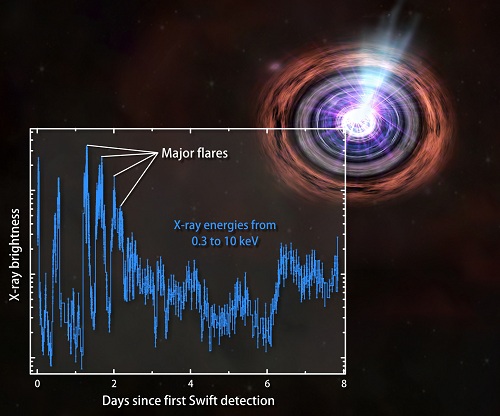
Image: GRB 110328A has repeatedly flared in the days following its discovery by Swift. This plot shows the brightness changes recorded by Swift’s X-ray Telescope. Credit: NASA/Swift/Penn State/J. Kennea.
William calls it the Draco Kill Shot. You can read more about GRB 110328A in NASA Telescopes Join Forces to Observe Unprecedented Explosion, which appeared on the Internet in early April of 2011. It’s considered to be the brightest and longest-lasting GRB ever observed, with high-energy radiation continuing to stream from its location a week after the event. Who would have thought an explosion that occurred 3.8 billion years ago would become part of the home investigations of a high schooler fascinated with radiation? For that matter, who just a few years ago would have dreamed that young minds would have so many useful tools at their disposal?
Today we have amateur astronomers aiding professionals in following up exoplanet finds and networks of people doing everything from cataloguing galaxies to monitoring marine debris and studying arthropods. With the tools of citizen science proliferating, we need to ramp up public outreach to show young people what can be done with modest equipment and dedication. I noticed that William Lucas and parents Diana and Richard stayed for the entire Huntsville workshop, a reminder that public interest once triggered can become a powerful ally in our work.

Cultural Diffusion and SETI
What happens to us if our SETI efforts pay off? Numerous scenarios come to mind, all of them speculative, but the range of responses shown in Carl Sagan’s Contact may be something like the real outcome, with people of all descriptions reading into a distant message whatever they want to hear. Robert Lightfoot (South Georgia State College) decided to look at contact scenarios we know something more about, those that actually happened here on Earth. His presentation in Huntsville bore the title “Sorry, We Didn’t Mean to Break Your Culture.”

Known as ‘Sam’ to his friends, Lightfoot is a big, friendly man with an anthropologist’s eye for human nature. His talk made it clear that if we’re going to plan for a possible SETI reception, we should look at what happens when widely separated groups come into contact. Cultural diffusion can happen in two ways, the first being prompted by the exchange of material objects. In the SETI case, however, the non-material diffusion of ideas is the most likely outcome. Lightfoot refers to ‘objects of cultural destruction’ in both categories, noting the distorting effect these can have on a society as unexpected effects invariably appear.
Consider the introduction of Spam to the islands of the Pacific as a result of World War II. The level of obesity, cancer and diabetes soared as cultures that had relied largely on hunting, farming and fishing found themselves in the way of newfound supplies. Visitors to some of these islands still note with curiosity that Spam can be found on the menus of many restaurants. Today more than half of all Pacific islanders are obese, and one in four has diabetes. On the island nation of Tonga, fully 69 percent of the population is considered obese.
Lightfoot mentioned Tonga in his talk, but I drew the above figures from the World Diabetes Foundation. Can we relate the continuing health problems of the region to Spam? Surely it was one of the triggers, but we can also add that the large-scale industrialization of these islands didn’t begin until the 1970s. Imported food and the conversion of farmland to mining and other industries (Nauru is the classic example, with its land area almost entirely devoted to phosphate mining) meant a change in lifestyle that was sudden and has had enormous health consequences.
Objects of cultural destruction (OCDs) show their devastating effects around the globe. The Sami peoples of Finland had to deal with the introduction of snowmobiles, which you would have thought a blessing for these reindeer herders. But the result was the ability to collect far larger herds than ever before, which in turn has resulted in serious problems of over-grazing. Or consider nutmeg, once thought in Europe to be a cure for the plague, causing its value to soar higher than gold. Also considered an aphrodisiac, nutmeg led to violence against native growers in what is today Indonesia and played a role in the creation of the East India Company.
But because SETI’s effects are most likely going to be non-material, Lightfoot homed in on precedents like the ‘cargo cults’ of the Pacific that sprang up as some islanders tried to imitate what they had seen Westerners do, creating radios out of wood, building ‘runways’ and calling for supplies. In South Africa, a misunderstanding of missionary religious teachings led the Xhosa people to kill their cattle, even though their society was based on herding these animals. Waiting for a miracle after the killings, a hundred thousand people began to starve. Said Lightfoot:
Think about contact with an extraterrestrial civilization in this light. There will be new ideas galore, even the possibility of new objects — plants, animals, valuable jewels. Any or all of these could be destabilizing to our culture. And just as they may destabilize us, we may contaminate them.
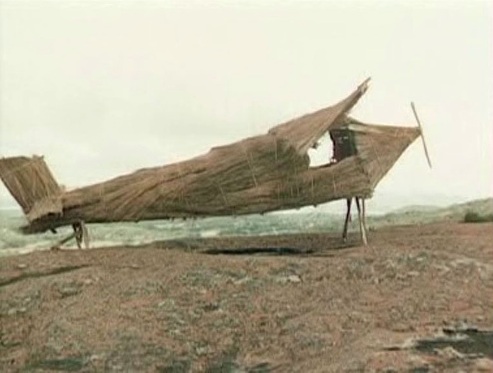
Image: Cargo cults reacted to advanced technology by trying to emulate it with their own tools, a reminder of the perils of contact between widely different cultures.
I think the most powerful message of Lightfoot’s talk was that this kind of destabilization can come where you would least expect it, and have irrevocable results. Tobacco, once used as a part of ritual ceremonies in the cultures where it grew, has become an object of cultural and medical destruction in our far more affluent society. Even something as innocuous as a tulip once became the object of economic speculation so intense that it created an economic bubble in 17th Century Holland and an ensuing economic panic.
What to do? Lightfoot told the crowd to search history for the lessons it contains about cultures meeting for the first time. We need to see when and why things went wrong in hopes of avoiding similar situations. If contact with an extraterrestrial culture someday comes, we’ll need a multidisciplinary approach to identify the areas where trouble is most likely to occur. A successful SETI reception could be the beginning of a philosophical and scientific revolution, or it could be the herald of cultural decline as we try to re-position our thinking about the cosmos.

Interstellar Studies: Surveying the Landscape
One of the things I love about writing Centauri Dreams is that I learn something new every day. Often this comes from the research needed for individual stories, but just as often it comes from readers suggesting new directions or seeing nuances in an earlier story that I had missed. Yesterday’s post on long-term thinking led to an exchange with Centauri Dreams regular NS, who questioned my ideas on longevity in the Middle Ages, and before long we were both digging up data to try to discover what the numbers really are. It’s an ongoing process, and if you’re interested in such arcana, you can follow it in yesterday’s comments thread.
If you’re just joining us and wondering why we’re discussing medieval longevity, it ties into what I was saying about long-haul construction projects like cathedrals, and the question of what a worker on one of these projects might have thought of his chances of seeing its completion. You can also chalk it up to a fascination with the Middle Ages that has always preoccupied me.
Of course, my interest in long-haul projects doesn’t mean I wouldn’t welcome much faster transportation methods to get to the stars than the worldships I sometimes write about. My friends at Icarus Interstellar have their own worldship study, Project Hyperion, in progress in the capable hands of Andreas Hein, but they also have as their centerpiece Project Icarus, which is an attempt to design a fusion starship that some of their members believe can fly in this century. This seems wildly optimistic to me but I would love to be proven wrong. Icarus Interstellar president Richard Obousy discussed all these matters at the recent workshop in Huntsville.
An Eye on Breakthrough Propulsion
“Interstellar Flight from Conception to Reality” was the title of his talk, and in it Obousy made the case that one of the drivers for the new enthusiasm for interstellar flight is the wildly accelerating pace of exoplanet discovery. He sees exploration as the ‘expression of a curious and energetic species,’ one also becoming aware of the need for planetary defense and the imperative for developing skills in deep space. But one of his key points — and I’ve heard him say this before — is that we tend to overestimate what we can do on a short time-frame, and underestimate what we can do over longer periods.

It’s a heartening thought for me because it means interstellar flight might take place sooner than the several centuries ahead I normally consign it to. Obousy ran through key discoveries at the atomic level, pointing out that it was no more than 70 years after we refined the model of the atom through the discovery of electrons, protons and neutrons that we developed the first nuclear thermal rocket. The history of flight tells the same tale. We have gone from theory to experiment to useful technology in a numbingly short time, from Kitty Hawk to the Moon landings.
Image: I don’t know why Richard Obousy would be difficult to photograph, but my shots of him from the conference all had one or another thing wrong with them, so I’m pulling this one from the Icarus Interstellar site.
While running through interstellar options from fusion to antimatter, Obousy told the Huntsville audience that he had a deep interest in breakthrough propulsion ideas, the kind of thing once actively studied at NASA through the Breakthrough Propulsion Physics project under Marc Millis. If we can go from Maxwell’s equations on electromagnetism to the world we see today in so short a time, what might we pull out of the theoretical physics of dark energy in another hundred years? In a way, it could be said that the Victorian era was the birthplace of the nuclear rocket, and Obousy wonders what string theory, supersymmetry, dark energy and dark matter may ultimately lead to as we take a similar path from theory to experiment to technology.
“Theoretical physics is the key to a future interstellar civilization,” Obousy said, suggesting that a world-class technical team could grow up around these ideas working one day with a breakthrough propulsion physics research lab. Icarus Interstellar obviously has such a project in mind as Obousy charts its future direction, and the beauty of the approach is that in gathering momentum, such an effort need not be costly, for the emphasis right now remains on theory rather than experiment as we chart the early stages of some of these concepts. We have much to learn. What constraints do the laws of physics place on advanced civilizations? What exactly is the dark energy field that evidently exerts negative pressure on spacetime?
Beginning of Interstellar Studies
Kelvin Long, president of the Institute for Interstellar Studies and editor of the Journal of the British Interplanetary Society, noted in his talk that a 2007 BIS conference had worked through many of the issues raised by Miguel Alcubierre in an often-referenced 1994 paper. It was Alcubierre who studied how spacetime could be warped to accelerate a spacecraft, identifying the basic physics problems that would have to be solved if such a thing were to happen (the conference identified nineteen of these, a daunting figure). The premise here is that while no object can move through spacetime faster than light, spacetime itself has no such restriction, as assumed through theories of cosmic inflation in the early moments of the universe.

But Long paused only briefly on Alcubierre. His intent was to offer an overview of interstellar concepts, and in doing so he ran through the contribution made by the BIS not only with an early Moon mission design but also through Project Daedalus, the fusion starship that came out of late-night sessions in various London pubs back in the 1970s (particularly the Mason’s Arms, I’m told — is it still there?). At the party before the conference, Kelvin talked to me about his view that interstellar studies really began with Les Shepherd’s 1952 paper “Interstellar Flight” (JBIS, Vol. 11, pp. 149-167). I think it’s a reasonable assumption, because Shepherd’s was the first paper I know of to approach the question with true scientific rigor.
In fact, Shepherd did a little worldship building of his own, as I noted in an obituary of the man written about a year ago. I’ll run the same quote I did then to make the point:
It is obvious that a vehicle carrying a colony of men to a new system should be a veritable Noah’s Ark. Many other creatures besides man might be needed to colonize the other world. Similarly, a wide range of flora would need to be carried. A very careful control of population would be required, particularly in view of the large number of generations involved. This would apply alike to humankind and all creatures transported. Life would go on in the vehicle in a closed cycle, it would be a completely self-contained world. For this and many other obvious reasons the vehicle would assume huge proportions: it would, in fact, be a very small planetoid, weighing perhaps a million tons excluding the dead weight of propellants and fuel. Even this would be pitifully small, but clever design might make it a sufficiently varied world to make living bearable.
But the paper goes on to look at antimatter options that could take starships up to relativistic speeds and considers not only time dilation but also the problems of running into stray gas and dust along the way. It’s a classic that’s well worth re-reading today. And it’s worth remembering that the JBIS ‘red cover’ issues devoted to interstellar studies set the standard for innovative thinking on the topic for many years. Although the British Interplanetary Society has run into a host of problems in the past few years, it’s heartening to see how much Kelvin has achieved as the new editor of JBIS in getting the publication back on schedule. Well done, sir.
I won’t go through all the interstellar propulsion concepts that Long and Obousy presented because they’re already part of our continuing discussion in these pages. Instead, I’ve asked both for a Centauri Dreams contribution, Obousy to talk about where Icarus Interstellar now stands and Long to give us more about JBIS and its history, including the fascinating fact that Project Daedalus came about largely to make a point about the Fermi paradox. Calling Daedalus ‘a balance between being credible and being bold,’ Long noted that even the most improbable starship design — if it could be shown to be feasible for future engineering — would have ramifications for Fermi’s ‘where are they’? question.
More on this in coming days, along with a series of stories on a space power concept that would constitute an essential early step in our building of a system-wide infrastructure. I’m also hoping to discuss an idea that is making a comeback, the colony starships of Robert Enzmann. Consolidating ideas from the Huntsville conference should keep me busy for quite some time.

